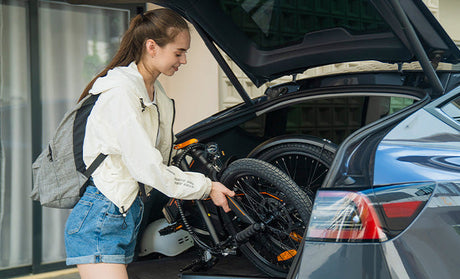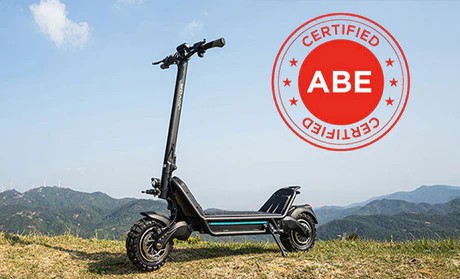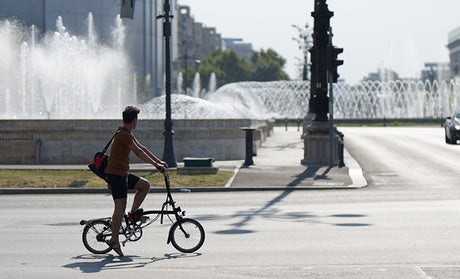Key Factors Affecting Battery Life
- Battery type (Lithium-ion, Lead-acid, etc.)
- Charging habits
- Maintenance and care
- Environmental conditions (temperature, humidity)
- Usage patterns (frequency, distance travelled)

Tips To Increase The Battery Life
Tip 1: Get familiar with your e-scooter's battery capacity and true range
The larger the battery’s capacity, the longer the battery should last, but your battery’s range is also impacted by a lot of different factors, such as the rider’s weight, the terrain (flat vs. hilly), and your speed. One thing to bear in mind is that you can’t always rely on the manufacturer’s advertised range. Often, electric scooter brands conduct the tests to calculate the range while the scooter is in ‘eco’ mode or travelling over completely smooth, flat ground and therefore these calculations are often a best-case scenario.
Tip 2: Always Use An Original Charger
It is really important to use an original charger on your e-scooters due to multiple reasons.
1. Original chargers are made especially for the battery of the e-scooter. Using an inexpensive or generic charger runs the risk of overcharging, overheating, or even catching fire, all of which could cause harm or damage.
2. Original chargers are made to give batteries the right voltage and current, extending their overall life. Using an off-the-shelf charger could eventually cause deterioration and shorten battery life.
3. A lot of e-scooter manufacturers provide warranties for their goods, most of which cover using the original chargers. If you use a non-original charger, the warranty can be voided and you’ll be on the hook for any necessary repairs or replacements.
4. Original chargers are made to charge batteries as efficiently as possible, converting energy with the least amount of waste. The e-scooter’s range may be reduced if a generic charger is used since it may lose more energy.
Generally speaking, original chargers are constructed with better components, which leads to a more dependable and consistent charging experience. Generic chargers could have inferior parts, which could result in an unreliable charge and possibly harm the e-scooter.
Tip 3: Avoid overcharging
Overcharging should be avoided as it can lead to battery degradation. Most electric scooters have built-in mechanisms to prevent overcharging, but it's still important to unplug the charger once the battery is fully charged, just in case.
Why?
- Heat generation. When a battery is overcharged, excessive electrical energy is continuously supplied to it. This leads to an increased flow of current, resulting in the generation of heat within the battery cells. Excessive heat can damage the internal components of the battery and reduce its overall efficiency.
- Chemical imbalance. Overcharging disrupts the delicate chemical balance within the battery. During the charging process, ions move between the positive and negative electrodes, storing and releasing energy. Overcharging can cause an accumulation of these ions, leading to an imbalance. This imbalance can result in the formation of unwanted chemical compounds, such as lithium metal deposits (plating), which can damage the battery's internal structure and potentially cause a short circuit.
- Capacity loss. Overcharging can cause the battery to lose its capacity to hold a charge over time. The excess electrical energy causes stress on the battery, resulting in the degradation of its active materials. This degradation reduces the overall energy storage capacity of the battery, leading to a decreased runtime and range for the electric scooter.
- Safety risks. Overcharging increases the risk of safety hazards, including the potential for the battery to overheat, swell, or even catch fire. Lithium-ion batteries are equipped with built-in safety mechanisms to prevent overcharging, but continuous overcharging can bypass these protections and pose a safety risk.
Tip 4: Never let the battery drain completely
Unlike other devices, it’s best to not allow your scooter’s battery to drain completely before charging again. This will wear it down faster than normal and reduce its capacity. Li-ion batteries last longer when they have stored charge, so if you want your battery to last longer, recharge it before it gets down to 10%, even when it’s not in regular use. If you don’t plan on using it for a while, fully charge your electric scooter before packing it away.
Tip 5: Charge in a Cool Environment
The temperature during the charging process can affect the battery's performance and longevity. Ideally, you should charge your electric scooter in a cool environment, away from direct sunlight or extreme heat. Elevated temperatures can cause the battery to degrade at a faster rate. If possible, find a shaded area or a well-ventilated space for charging your scooter.
Tip 6: Keep Your Scooter in a Temperature-Controlled Environment
Many electric scooters use lithium batteries. These batteries work best at temperatures between zero and 45 °C. Excessive temperatures, below 0 °C or over 45 °C, can damage the lithium batteries. The battery may swell, and liquid may leak. The cells can become deformed, and the electrolyte may freeze, making the cells short circuit. The battery can even explode. The internal temperature of your electric scooter can be checked with a temperature probe. Make sure that you know how to check the temperature and for how long.
1. Remove the battery from the scooter.
2. Remove the top cover and disconnect the connectors.
3. Please remove the battery and plug it into a power supply.
4. Insert the probe into the connector, and measure the resistance between the red wire and the black wire.
5. Compare the measured resistance values.
Tip 7: Store It Properly
If you plan to store your electric scooter for an extended period, it's important to take some precautions to protect the battery. Before storing, make sure the battery is at least 40-50% charged. Storing a fully drained battery for an extended period can lead to irreversible damage. Additionally, it's best to store your scooter in a cool, dry place to prevent any moisture or extreme temperature fluctuations that could harm the battery.
In Summary
In conclusion, maximising the battery life of your electric scooter requires careful attention to the charging process. Following the manufacturer's instructions, using a dedicated charger, avoiding overcharging, storing your scooter properly, and using a battery management system (if available) are all key steps you can take to ensure the longevity and performance of your scooter's battery.









